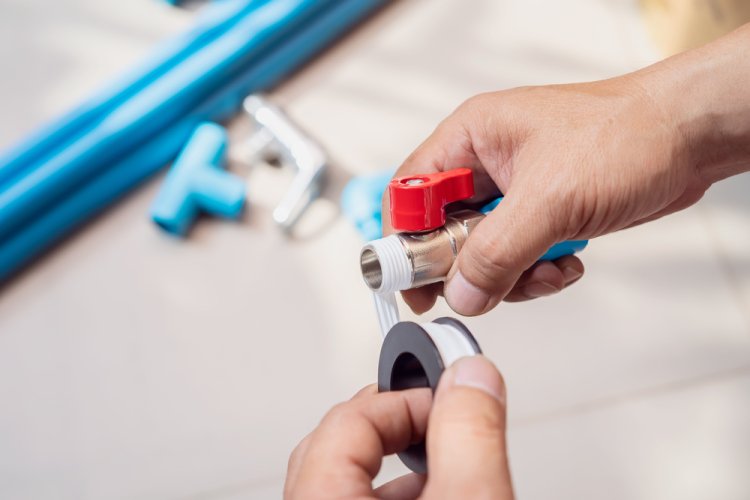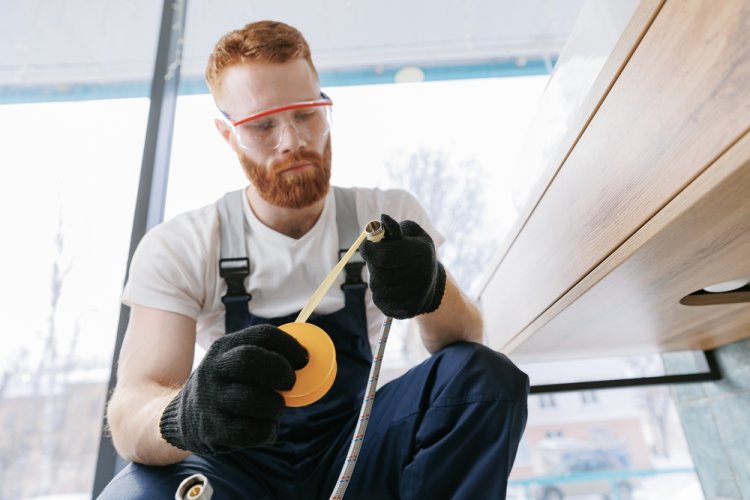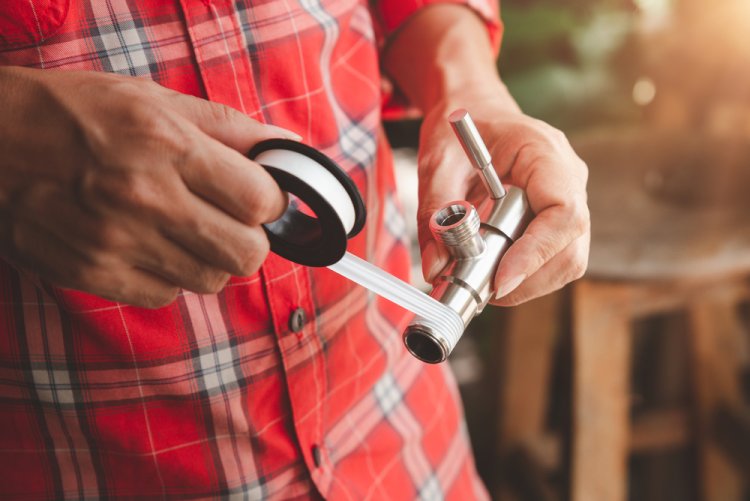Plumber’s Tape: When to Use it and When to Avoid It – A DIY Plumbing Guide
Learn when to use plumber’s tape for sealing and lubricating pipe joints, and when to avoid common mistakes.

Plumber’s tape can be used to both seal and lubricate threaded pipe joints. This is why it is often known within the industry as ‘thread seal tape’. While it is fairly safe and easy to use, there is also a right and a wrong way to apply it.
In the right circumstances, plumber’s tape is an excellent solution for DIY projects. However, if it is overlapping or applied to the wrong materials and surfaces, you’ll have another set of problems to deal with.
So, when is the best time to use it and when should you avoid it? Let’s explore the various ins and outs right now.
Plumber’s Tape: The Basics
Sometimes known as teflon tape, thread sealant, thread seal tape or PTFE, plumber’s tape is used to create a watertight seal between different pipe joints. Once applied, the overall aim is to prevent leaks from any threaded connections. The reason it is referred to as PTFE is because it is a polymer (synthetic substance) made up of polytetrafluoroethylene.
When used in the correct settings, plumber’s tape has the benefit of being:
- > Water repellent/resistant
- > Resistant to high temperatures
- > Chemically inert (nonreactive with pipe contact)
- > Lubricating
- > Low-friction
Plumber’s tape is regularly used in a variety of different residential and commercial environments. As we’ll go on to cover, there’s a good reason why it’s earned the moniker as the ‘plumber’s best friend’.
Plumber’s Tape Colours and Sizes
Typically, plumber’s tape is available in a solid white colour. However, different colour variations are often used to differentiate and identify different pipes. As an example, green plumber’s tape may be applied for oxygen lines, while yellow tape will usually be applied for gas lines.
Colour coding is a simple yet effective method that allows professional plumbers to clearly designate the type of connection they are dealing with. What’s more, colour directly correlates to the strength of the tape. If a job has specific safety considerations, only plumber’s tape of a certain colour and grade can be used.
The standard thickness of thread seal tape is between 2.5mm to 3.5mm. More specialist types will be thicker, such as the grey tape commonly used for stainless steel or heavy-duty red tape.
However, it’s important to note that the thickness doesn’t affect or change its basic properties. Plumber’s tape is still high strength, stretchable, and easy to tear regardless of its size.
How It Works
Now we can get down to the details and explain exactly how the plumber’s/thread seal tape works. The first thing to understand is that it is different from other common types of tape. While ‘sticky’ or ‘masking’ tape uses adhesives to seal two surfaces together, plumber’s tape is not actually sticky.
Essentially, it is more slippery than sticky. In this case, it works as a sealant and lubricant for the threads or connection between each pipe. Another benefit of this process is that it both lubricates the pipe threads and prevents them from getting stuck.
Imagine you’re assembling a jigsaw puzzle, but instead of the pieces fitting perfectly, they have small gaps and imperfections. If you want to make sure that pieces fit snugly and to make it easier to connect and disconnect them, you use a thin, flexible, and non-sticky fabric. This fabric wraps around the edges of each puzzle piece, filling in the gaps and allowing the pieces to slide together smoothly.
In this analogy:
- > The puzzle pieces represent the pipe threads.
- > The thin, flexible fabric is equivalent to plumber’s/thread seal tape.
- > The fabric filling the gaps and making the pieces slide together smoothly represents how the tape acts as both a sealant and a lubricant for the pipe threads.

Where Can Plumber’s Tape Be Applied?
Across the board, this tape is fairly straightforward and easy to use. Although it is most commonly applied by licensed plumbing professionals, there are situations where it also works for DIY projects.
Some of the most common applications include:
- > Pipe connections
- > Shower heads
- > Kitchen fittings
- > Faucet connections
- > Valves and angle stops
- > Toilet connections
- > Garden hose taps
- > Irrigation systems
Most plumber’s tapes are easy to tear and can therefore be applied by hand. However, there are also dispenser machines available when larger quantities are required.
When to Avoid It
While plumber’s tape is suitable for a range of different scenarios, there are also times when you should avoid it. For example, it is not recommended for PVC, copper, and PEX pipes, as well as any hydraulic or fluid based power systems.
Another important aspect to note is that applying not enough or too much tape to the connection are both problematic. Too much tape may crack the female adapter, and not enough is likely to cause a further leak.
Steps to Follow
If you’re experiencing an issue with leaking pipes, the best course of action is generally to contact a professional plumber straight away. However, if you’re trying to resolve a minor issue, these are our recommended steps to follow
- Any pipe connections must be dry and free of debris before any tape is applied.
- Once the area is clean, hold the pipe still and wrap the tape around the pipe connection in line with the same orientation and direction that the pipe naturally turns. If it is wrapped in the opposite direction, the tape may bunch up or unravel.
- Wrap the tape around the end of the pipe for a total of roughly two to four rotations.
- Because the tape doesn’t have an adhesive, the natural tension should keep everything in place.
- After the threads are wrapped, make sure that you tug the tape tightly as you rip it.
- Keep an eye over the tape to check that it doesn’t unravel, bunch up or become loose.
Another thing to note is that tape often comes with manufacturer instructions; following their guidelines is also a safe bet!

So, make sure that you follow these recommended steps, or contact a professional and let them handle the job. If you’re looking for an experienced, knowledgeable, and reliable plumber in Melbourne, you’re in great hands with MCN. We offer 24/7 emergency plumbing services and have expert knowledge of plumber’s tape.
How to Avoid Common Mistakes
Using thread seal tape effectively is crucial to prevent leaks and ensure a secure connection. Here are some common mistakes and how to avoid them:
Overtightening
- > Mistake: Over-tightening the connection after applying the tape.
- > Consequence: This can damage the threads and worsen the seal.
- > Solution: Tighten the connection normally. If the seal is not adequate, remove the tape and reapply it instead of over-tightening.
Improper Tape Removal and Reapplication
- > Mistake: Not removing the tape correctly if there is a leak.
- > Consequence: Continuing to use improperly applied tape can cause persistent leaks.
- > Solution: Remove the tape completely and reapply it. Make sure that the tape is pulled tight, applied in the correct direction, and smoothed at the end.
Wrapping in the Wrong Direction
- > Mistake: Wrapping the tape in the wrong direction.
- > Consequence: The tape can unravel when the connection is tightened, leading to leaks.
- > Solution: Apply the tape in a clockwise direction, matching the direction in which most pipes are tightened.
Where Can You Buy It?
Plumber’s tape is not only incredibly affordable but also available everywhere. Whether you’re shopping with Amazon, Bunnings or Coles, it’s never too hard to get your hands on some quality tape.
In most cases, all you’ll need is the standard white. However, as we noted earlier, certain projects will require different variations.
Still Unsure? Call in an Expert
About to take on a DIY project? If you’re considering thread seal tape but not quite sure how or where to apply it, it could be worth calling in the experts. Remember, applying it in the wrong way can lead to further leaks and issues, so it’s always better to be safe than sorry.
As experts in tap repairs, leaking pipes, and blocked drains, our plumbers know how to identify and fix a wide range of residential and commercial concerns. If plumber’s tape is applicable, our team will ensure that it is fitted correctly.
The MCN Plumbing team operates across all corners of Melbourne. Whether you’re looking for a plumber in Bayswater, Prahran or Epping, we’re never more than a phone call away. Reach out to us now for all of your emergency plumbing needs!

 0420 102 198
0420 102 198


